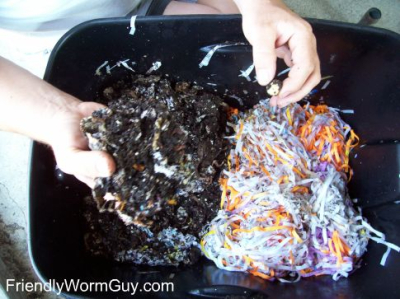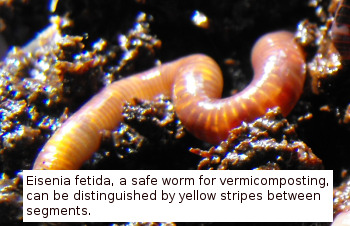
Setting up a new worm bin
 Although
various waste products (like sawdust and wood chips) can be used as
bedding in the worm bin, Binet Payne found that shredded paper was the
most effective. I've just about talked myself into buying a
shredder to turn junk mail into worm bedding since that's one of the
few waste products we don't fully utilize on our farm, and since I've
had bad luck keeping worms going in the bedding materials I've used in
the past (leaves, unshredded paper, etc.) The trick is that worm
bedding should be high in carbon to counteract the high nitrogen food
wastes, should hold water well to keep the worms moist, and should stay
fluffy to allow plenty of air to circulate through the bin.
Although
various waste products (like sawdust and wood chips) can be used as
bedding in the worm bin, Binet Payne found that shredded paper was the
most effective. I've just about talked myself into buying a
shredder to turn junk mail into worm bedding since that's one of the
few waste products we don't fully utilize on our farm, and since I've
had bad luck keeping worms going in the bedding materials I've used in
the past (leaves, unshredded paper, etc.) The trick is that worm
bedding should be high in carbon to counteract the high nitrogen food
wastes, should hold water well to keep the worms moist, and should stay
fluffy to allow plenty of air to circulate through the bin.
When preparing your worm
bin the first time (or adding bedding later to
cover up food), soak your shredded paper with three times its weight in
water. The perfect bedding is damp but not soggy, so you can't
squeeze any water out by hand. If the bedding is too wet, just
let it drain in the bin for a while before adding your worms. As
the bedding drains, sprinkle a shovelful of dirt over the damp paper to
provide grit for your worms and to stock bacteria to expedite the
decomposition process. Then toss in a bit of food waste and
manure worms (Eisenia fetida), cover them up, and let
your worms get to work.
 You
need to provide two pounds of worms for every daily pound of food
waste you'll be adding to the bin, which should also equal two pounds
of worms for every cubic foot of bin space. So, your 2 cubic foot
kitchen sink worm bin will need to start with 4 pounds of worms, and
your 8 foot by 4 foot by 1 foot bin will need 64 pounds of worms.
These
aren't the same worms you can dig up in your backyard, and buying
manure worms can be expensive, so you might need to stock your bin
with fewer worms than is recommended. In that case, add less food
waste to the bin at first, slowly putting in more as the worm
population grows. Binet Payne notes that 8 pounds of worms will
fully stock a 32 square foot bin within three months.
You
need to provide two pounds of worms for every daily pound of food
waste you'll be adding to the bin, which should also equal two pounds
of worms for every cubic foot of bin space. So, your 2 cubic foot
kitchen sink worm bin will need to start with 4 pounds of worms, and
your 8 foot by 4 foot by 1 foot bin will need 64 pounds of worms.
These
aren't the same worms you can dig up in your backyard, and buying
manure worms can be expensive, so you might need to stock your bin
with fewer worms than is recommended. In that case, add less food
waste to the bin at first, slowly putting in more as the worm
population grows. Binet Payne notes that 8 pounds of worms will
fully stock a 32 square foot bin within three months.
| This post is part of our Worm Cafe lunchtime series.
Read all of the entries: |
Want more in-depth information? Browse through our books.
Or explore more posts by date or by subject.
About us: Anna Hess and Mark Hamilton spent over a decade living self-sufficiently in the mountains of Virginia before moving north to start over from scratch in the foothills of Ohio. They've experimented with permaculture, no-till gardening, trailersteading, home-based microbusinesses and much more, writing about their adventures in both blogs and books.
Want to be notified when new comments are posted on this page? Click on the RSS button after you add a comment to subscribe to the comment feed, or simply check the box beside "email replies to me" while writing your comment.

I just set up my first worm bin a couple months ago and did a lot of reading about it at the time. I have used an old, broken Tupperware bin and the shredded credit card offers that have accumulated.
One thing i discovered is that, contrary to what is often stated, some paper and newsprint may contain toxins even without colored inks. Sorry i can't provide the reference -- i just took note of the fact and filed it as "interesting, but below threshold of useful". I think it was in a discussion of vermicomposting as "organic" practice.
Pick your battles.
Thanks for your great work sharing your projects, and congratulations on 4 and 2 year anniversaries!
Binet Payne was a bit leery of this toxicity too, and she went so far as to have her compost tested at a lab after she finished it. Her conclusion was that as long as you mix things up with lots of different types of paper and food, the toxicity isn't a problem.
I've read that fungi are great at breaking down problematic chemicals like that, and I suspect that they might go to work in a worm bin without us even knowing it.
Thanks for your congratulations!
Hi Anna,
Thanks for the reply. That was me who asked about my disappearing worms from my worm towers. I am sure my worms are compost worms as I got them from my Mother who has had a worm farm for years and years.
Should I be putting the worms on top or underneath the bedding layer (wet shredded paper)?
Should i put any dirt on top of the worms? Do worms eat in the tower at night perhaps and leave during the day which is why i can not see any? Do you think the worm that are in the tower would still be crawling around the soil in my raised beds or would they die?
Sorry for so many questions but i am really stumped as to what to do next.
Thanks in advance, Monique
Monique --- Thanks for checking back even though your original comment got deleted!
If the problem isn't the type of worm, it's probably the habitat. It shouldn't matter whether you put the worms on top of or under the shredded paper --- they'll move down to where they want to be. Dirt on top of the worms also shouldn't be necessary. But are you paying attention to temperature and moisture? Worms need it cool and damp, so if your worm tower is drying out or baking in the sun, the worms would move out. Ditto if you're adding dry paper rather than paper soaked in water and drained to about the consistency of a sponge. Finally, it could be a problem of cold temperature --- compost worms can't handle extremely cold weather, so they might have frozen over the winter and died. From my understanding, worm towers originated in Australia, where winters are more moderate --- I'm not positive they'll work over the winter in the northern U.S.
Unfortunately, if the worms are no longer in the tower, they probably aren't going to crawl back in. Compost worms don't last long in garden soil.
I hope that helps!